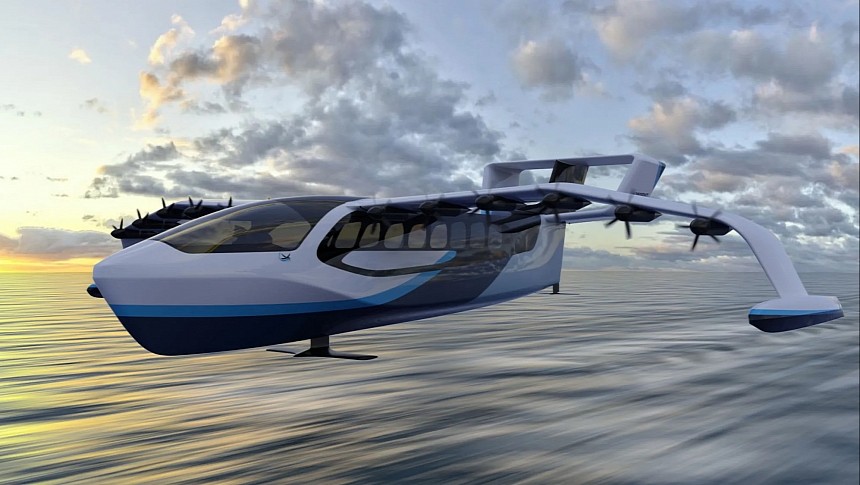Some might argue that this all-electric seaglider is even more exciting than all the various innovations related to green flight because it blends pioneering technologies from both aviation and maritime design. The Rhode Island-based Regent is ready to put these futuristic machines on the map in all parts of the world with coastal communities.
Regent is gearing up for a new important phase next year. That's when the full-scale prototype of its seaglider will kick off a flight test campaign with a pilot on board. This is the natural step after the Rhode Island manufacturer conducted the first electric seaglider flight last year, touted as the first of its kind worldwide.
Regent got all the support it needed for this next milestone. It secured $60 million with its latest funding round, bringing its total funding to $90 million. Its investors include huge names like Lockheed Martin, Japan Airlines Innovation Fund, Yamato Holdings, and UAE's Strategic Development Fund.
The manufacturer is also doing great in terms of orders, with more than 500 units worth over $8 billion sold worldwide to airlines and ferry operators. The brand's first production seaglider is set to be delivered to Southern Airways, which will operate in Hawaii under its Mokulele Airlines brand.
This revolutionary electric seaglider will officially be named Viceroy. Viceroy will be able to carry up to 12 passengers, cruise at 180 mph (290 kph), and cover 180 miles (290 km) on a single charge.
But Regent isn't stopping there. It plans to introduce an advanced version of its seaglider, called Monarch, by the end of this decade. The Monarch will boast a huge 100-passenger capacity coupled with a 500-mile (804 km) range.
In either version, here's how this e-seaglider operates: it takes off from the dock like a traditional boat, then starts to speed up and rise on its hydrofoil (an innovative maritime technology); once it reaches open water, the seaglider then retracts its foil and takes flight, accelerating to cruise speed.
The game-changing hydrofoil addition is what allows this vehicle to ride smoothly, just as it leaves crowded harbors before it's free to take flight like an airplane. From then on, the seaglider stays within one wingspan over the open water.
This futuristic machine operates in three modes (boat, hydrofoil, aircraft) using conventional boat controls and advanced digital flight software.
Last year's flight claimed to be the first of its kind, where a craft took off from hydrofoil to wing-borne flight. Viceroy will also be the first craft to combine wing-borne flight speed with hydrofoils' wave tolerance. It has the potential to revolutionize coastal transportation with high performance and zero emissions.
Regent's Viceroy seaglider is set to enter commercial service by 2025.
Regent got all the support it needed for this next milestone. It secured $60 million with its latest funding round, bringing its total funding to $90 million. Its investors include huge names like Lockheed Martin, Japan Airlines Innovation Fund, Yamato Holdings, and UAE's Strategic Development Fund.
The manufacturer is also doing great in terms of orders, with more than 500 units worth over $8 billion sold worldwide to airlines and ferry operators. The brand's first production seaglider is set to be delivered to Southern Airways, which will operate in Hawaii under its Mokulele Airlines brand.
This revolutionary electric seaglider will officially be named Viceroy. Viceroy will be able to carry up to 12 passengers, cruise at 180 mph (290 kph), and cover 180 miles (290 km) on a single charge.
But Regent isn't stopping there. It plans to introduce an advanced version of its seaglider, called Monarch, by the end of this decade. The Monarch will boast a huge 100-passenger capacity coupled with a 500-mile (804 km) range.
In either version, here's how this e-seaglider operates: it takes off from the dock like a traditional boat, then starts to speed up and rise on its hydrofoil (an innovative maritime technology); once it reaches open water, the seaglider then retracts its foil and takes flight, accelerating to cruise speed.
The game-changing hydrofoil addition is what allows this vehicle to ride smoothly, just as it leaves crowded harbors before it's free to take flight like an airplane. From then on, the seaglider stays within one wingspan over the open water.
This futuristic machine operates in three modes (boat, hydrofoil, aircraft) using conventional boat controls and advanced digital flight software.
Last year's flight claimed to be the first of its kind, where a craft took off from hydrofoil to wing-borne flight. Viceroy will also be the first craft to combine wing-borne flight speed with hydrofoils' wave tolerance. It has the potential to revolutionize coastal transportation with high performance and zero emissions.
Regent's Viceroy seaglider is set to enter commercial service by 2025.







